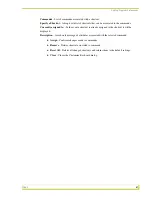
Basic Operations
32
IREdit
6.
Paste the code into the text edit field provided by the wizard.
7.
When text has been entered into the edit control, the page’s
Next
button will then become
enabled. No validation will be performed on the text until the
Next
button is pressed, which
launches the translation process.
8.
Click
Next
to begin translation to AMX-format.
When translating the discrete IR hex-format text, all blank, carriage-return, and line-feed characters
will be removed first, so spacing and line arrangement are irrelevant. Since all hex-format codes are
composed of four-byte blocks, the number of remaining digit characters must be evenly divisible by
four. All digits must be in the hex range 0-9 and A-F (or a-f). If the input text fails to translate, the
program will present an error message box and allow the user to re-enter or edit the input text and
try again.
IREdit will attempt to translate the text into the AMX proprietary IR format and write it to the
selected function in the .IRN/.IRV file in the same manner as the IRIS capture functionality
currently operates.
9.
If the translation operation is successful, the wizard will then proceed to the final page and
display the result of the operation. Use the
Back
button to redo the process or click the
Finish
button to exit the wizard.
10.
Repeat process to add more discrete IR hex code functions.
The Discrete IR Hex-format code can also be typed in verbatim.
Discreet IR hex-format codes must be either raw oscillated code (first four-byte
block = 0000) or raw unmodulated code (first four-byte block = 0100) in order to
be translated into the AMX proprietary format.
















































